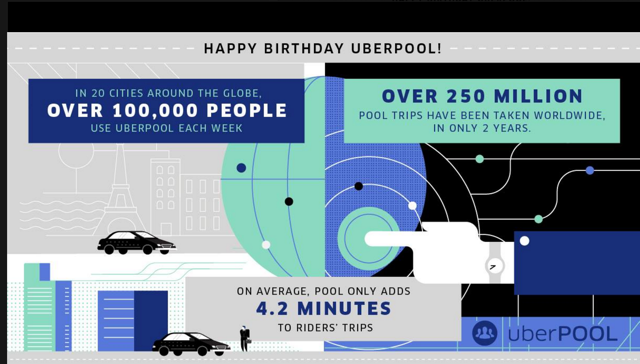
By Darrell Stone
This past May, we announced uberPOOL’s availability as a product option in the Uber API. Since launch, we have had hundreds of developers and some of our largest partners like Google Maps optimize their integrations to better support uberPOOL into their Ride Request flows.
Tweaking their implementation to better support uberPOOL has enabled developers to offer their users the smoothest possible user experience when they choose our most affordable product, enhancing the effectiveness of their Uber API integration.
While the initial uptake of uberPOOL integrations was encouraging, we still see a huge opportunity for both new and existing partners:
- New developers: Offer your users uberPOOL plus all other Uber ride products (eg. Uber X, Black Car, etc) with just a few lines of code.
- Existing developers: Optimize your uberPOOL implementation to create a better ride request experience for your users.
Here are three reasons why you should optimize your API integration to better support some of the advanced workflows of uberPOOL today.
1. Tap into uberPOOL’s rider growth
uberPOOL’s growth in just a few short years has been staggering. When we celebrated uberPOOL second birthday in July, we shared some incredible stats that highlight how far we have come as of July 2016:

By optimizing your uberPOOL API integration, you can offer a better experience for a highly relevant transportation option that many of your users are likely already using to move around their city.
2. Increase signups and engagement with your app
Always focused on improving the user experience, the Google Maps team was one of Uber’s first partners to recognize the value of optimizing uberPOOL within its mobile Maps products. The team understood that lower travel costs with uberPOOL would unlock new use cases for its users, such as improving their daily commute. Early results in markets where uberPOOL was first available have been very promising with an increase in trips and signups.
3. Save the planet
Sharing rides with uberPOOL has had an incredibly positive impact on our environment. In the first seven months of 2016, uberPOOL has eliminated the need for over six millions gallons of fuel and as a result, preventing 55,560 metrics tons in CO2 pollution. Optimizing uberPOOL in your app is a practical way to show your users that you care about making our planet a healthier place.

*As of July 2016
Enhance your uberPOOL API integration today
Great news! Our Button, Deeplink, and Ride Request Widget products already provide the full uberPOOL experience. To add uberPOOL to your app using these easy-to-use developer products, please check out our newly launched rides requests products page.
However, to build a more deeply integrated uberPOOL experience in your app using our REST API, here are a few recommended features to add for your users:
- Upfront Fares — With Upfront Fares, you can temporarily lock a price and arrival time for a ride request using a newly introduced property, fare_id. Integrating this feature will let your users know exactly what they will pay for their trip. We also recently just announced support for Upfront fares for all our products in the Riders API 1.2 — so this is the perfect opportunity to upgrade!
- Seat Count — You should also ask your users how many seats they will need in case they’re traveling with another person. Benefits for adding seat count are more accurate price estimates and feature parity with the Uber app.
- Matching State / Other Riders — Let your users know if Uber has matched you with other riders or is searching for additional riders along your route. You can also display fellow passengers’ names when your users are matched with other riders.
- Waypoints — Provide additional trip context by displaying waypoints and co-riders’ “pickup” and “dropoff” locations.
We look forward to offering the magic of uberPOOL to many more customers with new features and simpler integrations for our developer community in the months ahead. For more information, please check out the uberPOOL section in the Rides API tutorial here.

⚀ To get updates from the Uber Developer team in the future, follow our publication or follow us on Twitter.
Posted by Darrell Stone